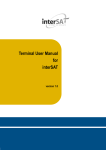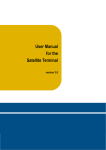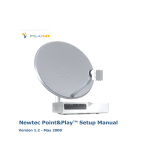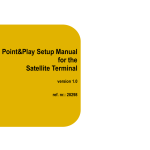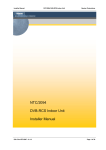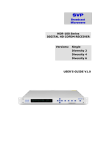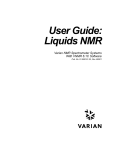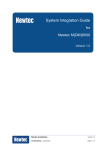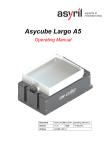Download User Manual - Hellas Sat
Transcript
User Manual for HELLAS SAT Terminal version 1.9.2.4 User Manual for HELLAS SAT Terminal © 2008 Newtec cy. Any unauthorised duplication or distribution is expressly prohibited. Unless specifically authorised no part of this document may be reproduced in any form without the prior written consent of Newtec Cy. Newtec cy Laarstraat 5 9100 Sint-Niklaas, Belgium General: +32 (0)3 780 65 00 www.newtec.eu Fax +32 (0)3 780 65 49 General: [email protected] version 1.9.2.4 i SHAPING THE FUTURE OF SATELLITE COMMUNICATIONS User Manual for HELLAS SAT Terminal Who Should Read This WHO SHOULD READ THIS This User Manual is intended for the user of the HELLAS SAT terminal. It provides safety precautions, a description of the HELLAS SAT terminal and a detailed description of how to use the GUI (Graphical User Interface). First-line troubleshooting information is also included. Version history and applicability Document version Date Subject version 1.9.2 21/11/2007 1.6 Author Comments Creation for this software release Table 1 - Related documentation The details of the installation and pointing of the HELLAS SAT dish are described in the Point&Play set-up manual. version 1.9.2.4 ii SHAPING THE FUTURE OF SATELLITE COMMUNICATIONS Important Safety Precautions User Manual for HELLAS SAT Terminal IMPORTANT SAFETY PRECAUTIONS Install the HELLAS SAT modem and antenna according to local regulations Before installing the HELLAS SAT modem, please make sure that your electrical outlet is properly wired and your computer equipment is properly grounded. Consult with a licensed electrician if in any doubt; Please read and understand all operating instructions in your user’s guide located in the HELLAS SAT modem shipping box; Please read and understand all safety precautions prior to connecting any cables to the HELLAS SAT modem. Always observe the following warnings: There are no user-serviceable parts in your system. There are potentially lethal voltages inside the equipment. It should only be opened by a technician trained and certified to service the product; RF Radiation Hazard. The transmitting equipment is capable of generating RF levels above the maximum permissible exposure level. Do not enter the radiation beam pattern of the transmitter feed horn and/or antenna dish when the transmitter is on. Keep the space between feed horn and reflector clear! When the HELLAS SAT modem is powered on, DC voltages are present on the rear panel Tx and Rx connectors; To prevent fire or shock hazard, do not expose this appliance to rain or moisture. The apparatus must not be exposed to dripping or splashing and no objects filled with liquids, such as vases, should be placed on the apparatus; Postpone HELLAS SAT modem installation until there is no risk of thunderstorm or lightning activity in the area; To prevent electrical shock, if the unit is provided with a polarized plug, do not connect the plug into an extension cord, receptacle or other outlet unless the plug can be fully inserted with no part of the blades exposed; The in-line power supply input power cord must be connected to a properly grounded three-prong AC outlet. Do not use adapter plugs or remove the grounding prong from the plug; The in-line power supply input power cord must not be used when damaged in any form! Always observe the following cautions: version 1.9.2.4 iii User Manual for HELLAS SAT Terminal Important Safety Precautions Always use the in-line power supply with the HELLAS SAT modem. Using a different power supply may cause equipment damage; To ensure regulatory and safety compliance, use only the provided power and interface cables or cables which conform to the specifications within this manual; Do not open the unit. Do not perform any servicing other than that contained in the installation and troubleshooting instructions. Refer all servicing to qualified service professionals; Avoid damaging the HELLAS SAT modem with static, by first touching the coaxial cable connector when it is attached to the earth grounded coaxial cable wall outlet. Always first touch the coaxial cable connector on the HELLAS SAT modem when you are disconnecting or re-connecting your Ethernet cable from the HELLAS SAT modem or your computer; To prevent overheating, do not block the ventilation holes on the sides and top of the unit; Only wipe the unit with a clean, dry cloth. To avoid equipment damage, never use fluids or similar chemicals. Do not spray cleaners directly on the unit or use forced air to remove dust; The user should install an AC surge arrestor in the AC outlet to which this device is connected. This to avoid damaging the equipment by local lightning strikes and other electrical surges; Notices: This product was qualified under test conditions that included the use of the supplied cable between the components. To be in compliance with regulations, the user must use this cable – or equivalent – and install it properly; Different types of cord sets may be used for connections to the main supply circuit. Use only a main line cord that complies with all product safety requirements of the country of use; Installation of this product must be in accordance with national wiring codes; version 1.9.2.4 iv User Manual for HELLAS SAT Terminal Table of Contents TABLE OF CONTENTS Who Should Read This............................................................................................ii Important Safety Precautions................................................................................iii Table of Contents ....................................................................................................v 1 Introduction ....................................................................................................7 1.1 HELLAS SAT Terminal Documentation...........................................................7 1.2 About the HELLAS SAT Terminal....................................................................7 1.3 Installation Tasks .............................................................................................8 2 Getting to know your HELLAS SAT Terminal .............................................9 2.1 The IPmodem .................................................................................................9 2.1.1 The IPmodem Front Panel ..........................................................................9 2.1.2 The IPmodem Back Panel...........................................................................9 2.1.3 The Power Supply .....................................................................................10 2.1.4 Cables........................................................................................................10 2.2 The iLNB ........................................................................................................14 3 Terminal Web Interface ...............................................................................15 3.1 Prepare the Settings of Your Computer ........................................................15 3.2 How to Access the Terminal Web Interface? ................................................15 3.2.1 With Satellite Connection ..........................................................................15 3.2.2 No Satellite Connection .............................................................................16 3.3 3.3.1 General Layout ..........................................................................................16 3.3.2 Menu Structure ..........................................................................................17 3.4 Reboot the IPmodem .....................................................................................18 3.5 LEDs in the Status Bar ..................................................................................18 3.5.1 Ethernet LED .............................................................................................18 3.5.2 Satellite LED ..............................................................................................19 3.5.3 Software LED ............................................................................................19 3.6 Introduction ................................................................................................19 3.6.2 Overview....................................................................................................20 3.6.3 Interface Statistics .....................................................................................23 3.7.1 v Status Page ...................................................................................................19 3.6.1 3.7 version 1.9.2.4 Overview Web Interface ................................................................................16 Configuration..................................................................................................23 Ethernet Interface ......................................................................................23 Table of Contents 3.7.2 Satellite Interface.......................................................................................25 3.7.3 Multicast ....................................................................................................29 3.8 vi Device ............................................................................................................32 3.8.1 Software ....................................................................................................32 3.8.2 Hardware ...................................................................................................35 3.9 version 1.9.2.4 User Manual for HELLAS SAT Terminal Test ................................................................................................................35 3.9.1 On Screen Test Results ............................................................................36 3.9.2 Filed Test Results......................................................................................37 3.9.3 Test Descriptions.......................................................................................38 4 Appendix A - Local Network Configuration ..............................................40 4.1 Connect a Single Computer to the IPmodem ................................................40 4.2 Connect a LAN to the IPmodem ....................................................................41 5 Appendix B – Checking and Changing your IP Settings .........................42 5.1 Introduction ....................................................................................................42 5.2 Windows Vista ...............................................................................................42 5.3 Windows XP...................................................................................................45 5.4 Mac OS X.......................................................................................................46 6 Appendix C – Troubleshooting Guide .......................................................49 7 Appendix D – Acronyms .............................................................................52 8 Appendix E – Specifications.......................................................................54 8.1 IPmodem (indoor unit) ...................................................................................54 8.2 iLNB (outdoor unit)........................................................................................55 9 Appendix F - Licenses.................................................................................57 User Manual for HELLAS SAT Terminal Introduction 1 INTRODUCTION 1.1 HELLAS SAT Terminal Documentation The HELLAS SAT Terminal documentation consists of: The HELLAS SAT Terminal Documentation exists out of three documents: 1. This document, describing the features and terminal web interface of the IPmodem; 2. The Point and Play manual describing the installation and pointing of your antenna; 3. The pointing data, consisting of the information you need to point your antenna to the correct position. 1.2 About the HELLAS SAT Terminal The HELLAS SAT Terminal is state of the art equipment allowing cost effective, plug & play connection to an extended variety of IP-based applications. The HELLAS SAT Terminal consists of: A small size, high quality, easy to install satellite antenna (79 cm); An interactive LNB (iLNB); An IPmodem providing an Ethernet connection to the computer of the end-user or Local Area Network (LAN). Figure 1– HELLAS SAT Terminal version 1.9.2.4 7 User Manual for HELLAS SAT Terminal Introduction The interactive iLNB low power equipment is light weight, easy-to-install and highly reliable. All parts are built using state-of-the-art microwave design that guarantees an unequalled reliability for many years. Connected to the interactive iLNB by means of transmit and receive cables, the high speed IP modem provides an asymmetrical 2-way broadband access to IP applications (e.g. Broadband Internet Access). Its small size, in line with the best practice in the telecom and IT industries, makes it suited for any type of user, business or consumer. 1.3 Installation Tasks To ensure proper installation of the HELLAS SAT Terminal, the following tasks must be performed. These tasks are described in detail in the Point&Play Manual of your IPmodem. Prepare the installation site and unpack the devices; Select a suitable location to set up the antenna. A clear view to the South must be available (satellite position). The distance between the antenna and the IPmodem may not exceed 50 metres. Ideally, this distance shall not exceed 30 metres if making use of the cable provided with the HELLAS SAT Terminal; Set up the antenna pole and attach the masthead to it; Attach the antenna to the masthead; Attach the iLNB to the antenna; Place the IPmodem in a clean, dry room at maximum 30 m (cable length) from the antenna site; Connect the IPmodem to the iLNB using the Rx and Tx coax cables; Connect a computer (desktop or laptop) to the IPmodem; Power the IPmodem; Use a web browser on the computer to access the Terminal Web Interface; Point the antenna towards the correct satellite, fine-tune pointing and verify the cross polarisation; Configure the terminal using the web interface and/or check the connectivity. version 1.9.2.4 8 User Manual for HELLAS SAT Terminal Getting to know your HELLAS SAT Terminal 2 GETTING TO KNOW YOUR HELLAS SAT TERMINAL 2.1 The IPmodem 2.1.1 The IPmodem Front Panel (1) (2) (3) (4)(5) Figure 2– The IPmodem Front Panel Nr What Description (1) Power LED Green continuous – when powered up. (2) Warning LED Yellow continuous – when the terminal is not logged on to the satellite network. (3) LAN indicator LEDs Left: Green continuous – link layer status. Right: Green blinking – Ethernet frames are received or transmitted. (4) Rx indicator LED Green continuous – forward satellite signalling receiving. (5) Tx indicator LED Green blinking – traffic transmitting via the satellite link. Table 2 – Description of the Elements on the IPmodem Front Panel 2.1.2 The IPmodem Back Panel (4) (1) (2) (3) Figure 3– The IPmodem Back Panel version 1.9.2.4 9 (5) Getting to know your HELLAS SAT Terminal User Manual for HELLAS SAT Terminal Nr What Description (1) Tx connector Indoor connection for the transmit coax cable. (2) Rx connector Indoor connection for the receive coax cable. (3) Reset button Reboot: press once briefly (hold less than 5 seconds); Factory Reset: press and hold for more than 5 seconds. Resetting will also reboot the terminal and change all the IP-settings back to the default factory settings. (4) 15V power cable connector Power connector (5.5/2.5mm plug). (5) Ethernet cable connector Connection for the LAN, type RJ-45 (Ethernet cable). Table 3 - Description of the Elements on the IPmodem Back Panel 2.1.3 The Power Supply Figure 4 - IPmodem Power Supply Universal input range: nominal 100 – 240 Volt / 50 – 60 Hz; IEC320/C8 socket; CE approved; Output 15V / 2A; Plug 5,5 x 2,5 mm. 2.1.4 Cables 2.1.4.1 Ethernet Cables Included with your HELLAS SAT Terminal is a crossed red Cat-5 Ethernet cable with RJ-45 connectors. This cable is approximately 2 m long. It will be used to connect the IPmodem to your computer. version 1.9.2.4 10 Getting to know your HELLAS SAT Terminal User Manual for HELLAS SAT Terminal The IPmodem Ethernet connection also supports auto cross-over. Alternatively, a straight Ethernet cable can be used. 2.1.4.2 Coaxial Cables There are two separate cables between the antenna and the indoor equipment: the receive cable (Rx) and transmit cable (Tx). These coaxial cables (coax) are approximately 1 cm in diameter and are 30 m long. Delivered with your system is a combined twin cable with Rx and Tx cable attached to each other. The outdoor F-connectors must be compression types of durable construction and each have a rubber boot to effectively seal-off the connection when mated with the iLNB. The F-connectors are not attached to the cable yet for easy installation of the cable. Four screw-on connectors are delivered with the coax cable. Specifications of the coaxial cable: RG6 foam equivalent; Specified up to 3GHz; F-connectors. For an installation that requires a cable longer than 30 metres, another cable (set) can be used. The overall requirement is then: Attenuation @ 3000 MHz < 20 dB The provided cable has an attenuation of ~ 14 dB @ 3000MHz (30 m of cable). Figure 5- Coaxial Twin Cable with Connectors Attached version 1.9.2.4 11 Getting to know your HELLAS SAT Terminal 2.1.4.3 User Manual for HELLAS SAT Terminal The Pointing Aid The pointing device, with the functionality as shown in Figure 6, is delivered with an earphone as displayed in Figure 7 and appropriate battery. Figure 6 – Pointing Device The dimensions of the device are: Height: 29.02 mm; Length: 81.82 mm; Width: 61.56 mm. Figure 7 – Earphone 2.1.4.4 Antenna Overview The antenna comprises five parts: Antenna pole; - See below for the antenna pole requirements; Masthead; version 1.9.2.4 12 Getting to know your HELLAS SAT Terminal User Manual for HELLAS SAT Terminal - Completely pre-assembled; - Elevation and azimuth fine-pointing adjust cams. Antenna reflector (dish); - 79 x 85 cm pressed sheet metal with heavy-duty rim; - Steel is passivated and epoxy powder coated; - Fixed with 4 bolts. Feed arm; - Feed Arm is a steel part, precision formed; - Steel is passivated and epoxy powder coated; - Fixed to masthead with 2 x M6 bolts; - Feed clamp snaps inside feed arm; - Feed clamp is Glass-Filled Nylon; - All plastic parts are UV-stabilised. iLNB (see section 2.2 for more information). Figure 8 - Antenna Overview & Elements Antenna Pole Requirements When selecting an antenna pole, keep in mind the following dimensions: Dimensions; - Minimum diameter: 40mm; Maximum diameter: 70mm; - Also see Figure 9 for more dimensions. Galvanised steel; Solid base / fixation. The mechanical forces that need to be considered in the fixation of the antenna pole are shown in the picture below. version 1.9.2.4 13 User Manual for HELLAS SAT Terminal Getting to know your HELLAS SAT Terminal Figure 9 - Antenna Pole Stress and Forces 2.2 The iLNB The iLNB has an integrated casing and is fully sealed except for its ventilation slots. (2) (3) (1) Figure 10 - iLNB > Perspective and Bottom View Nr What Description (1) Feed horn Radiating feed horn of the iLNB, pointed towards reflector. (2) Tx connector Outdoor connection for the transmit coax cable. (3) Rx connector Outdoor connection for the receive coax cable. Table 4 - Description Elements of the iLNB version 1.9.2.4 14 User Manual for HELLAS SAT Terminal Terminal Web Interface 3 TERMINAL WEB INTERFACE 3.1 Prepare the Settings of Your Computer Check if your computer is set to DHCP. This way the computer can receive an IP address from the IPmodem. Follow the procedure in Appendix B – Checking and Changing your IP Settings to check and/or change your IP settings. 3.2 How to Access the Terminal Web Interface? 3.2.1 With Satellite Connection In the normal operational mode a connected computer should be configured in DHCP mode to retrieve an IP address automatically and to retrieve the DNS server. The terminal acts as a DHCP server for the computer. Browse to the web interface Type the IPmodem’s address in the address bar of the browser: 192.168.1.1. You will be re-directed to the Status page of the terminal. Figure 11 – The IPmodem’s Address in the Address bar of the browser Alternatively, use the Default Gateway address to reach the web interface. See Appendix A – Local Network Configuration for more information. It is possible that during first logon the terminal will perform an upgrade with the latest software since you cannot login using the old SW. This process can take up to ten minutes. You may NOT interrupt the terminal yourself during this period, e.g. by rebooting or powering down. If newer software is available, the terminal will: Download this software; Install this software Reboot the terminal; Logon to the network again. version 1.9.2.4 15 Terminal Web Interface 3.2.2 User Manual for HELLAS SAT Terminal No Satellite Connection Make sure your computer is able to receive an IP address via DHCP, by following the procedure in Appendix B – Checking and Changing your IP Settings. When the terminal is not linked to the satellite network, after three minutes, the computer will automatically receive its IP address, via DHCP, from the IPmodem and you will then be able to browse the web interface: If no DHCP address is assigned to your terminal: remove the Ethernet cable from your computer, wait a few seconds, and plug the Ethernet cable back into your computer. Type the IPmodem’s address in the address bar of the browser: 192.168.1.1. You will be redirected to the Status page of the terminal. If the problem remains, you need to assign a static IP address to your computer by following the procedure in Appendix B – Checking and Changing your IP Settings. 3.3 Overview Web Interface 3.3.1 General Layout Figure 12 – Page Layout of Web Interface Each of the web interface pages contains the same elements. A – Banner The banner contains the Newtec logo and shows the Air MAC address. B – Status bar version 1.9.2.4 16 Terminal Web Interface User Manual for HELLAS SAT Terminal The status bar always shows the most important status LEDs. This information will be specified in the body of the Status page. C – Menu structure On the left hand side of the page the site navigation is found. Click an item to select it. The menu structure may differ depending on your login status. D – Body The actual content of the web interface is shown in the body. It always shows the page title and one or more content blocks or forms. 3.3.2 Menu Structure The menu structure of the web interface of the web interface is described below (see Figure 13). Status Check on the device and network status. Configuration - Ethernet Interface Check and alter the Ethernet interface configuration. - Satellite Interface Check and alter the Satellite interface configuration. - Multicast Check and alter the Multicast configuration. Device Interface - Software Check on or alter the software version. - Hardware Check the Hardware version. Test Run tests on the device. Figure 13 - Menu Structure for the Normal User version 1.9.2.4 17 User Manual for HELLAS SAT Terminal Terminal Web Interface 3.4 Reboot the IPmodem See section 2.1.2 for similarities with the hardware button reboot. Figure 14 – Location of the Reboot Link Click the [Reboot] link at the right of the status bar to reboot the terminal. Two options are provided: - Normal Reboot: This will trigger a normal device reboot. - Factory Reset: This will force a factory reset of the terminal. The following settings are reset to default values: management IP address and netmask. Choose one of the above options. The terminal will reboot and return to the Status page. This may take up to one minute, including satellite link initialisation. The reboot of the terminal is needed when a (re)configuration has been performed. Changes may not take effect until after the next reboot 3.5 LEDs in the Status Bar 3.5.1 Ethernet LED The Ethernet LED gives the general status of the Ethernet connection to the IPmodem. LED colour code Description Red Connection is not OK. Yellow Connection is OK, but no DHCP address is given. Green A DHCP address is given and the connection is OK. Table 5 - Status LEDs > Ethernet version 1.9.2.4 18 User Manual for HELLAS SAT Terminal Terminal Web Interface 3.5.2 Satellite LED The Satellite LED gives the general status of the Satellite connection to the IPmodem. LED colour code Description Red No connectivity, no valid signal received. Yellow A valid signal was received. The terminal is busy logging in on the satellite network. Green The system is operational and the user is logged in on the satellite network. Table 6 - Status LEDs > Satellite 3.5.3 Software LED The Software LED gives the general status of the installed software or the updates. LED colour code Description Red The terminal has a newer software version than the running software version, and The newer software version was not selected because the software validation process failed. See Appendix C – Troubleshooting Guide for possible actions and follow-up. Yellow The terminal is retrieving new software via satellite. This can take up to 10 minutes. Green No problem. The terminal is running with the latest software version. Table 7 - Status LEDs > Software 3.6 Status Page 3.6.1 Introduction There are three parts to the Status Page as shown in Figure 15, which are described in more detail in the following sections: Overview: This part gives an overview of the IPmodem, demodulator and software state. Pointing: This part gives an overview of the pointing status and pointing carrier selection. version 1.9.2.4 19 User Manual for HELLAS SAT Terminal Terminal Web Interface Interface Statistics: This part gives an overview of the IP modem statistics. Figure 15 – Status Page 3.6.2 Overview 3.6.2.1 Modem State The IPmodem state is indicated by a coloured LED and a state description. For the LED colour code, refer to Table 6. The possible modem state descriptions are given below. Modem state Description Satellite network lookup The terminal is looking for the satellite network. Synchronising The terminal found the satellite network and time synchronisation. Synchronised The terminal is synchronised and can directly log in on the satellite network when IP traffic is received via the Ethernet interface. Network login The terminal is trying to log in on the satellite network. Operational The terminal is logged in. Table 8 - Status Page > Modem State version 1.9.2.4 20 User Manual for HELLAS SAT Terminal Terminal Web Interface 3.6.2.2 Demodulator The Demodulator state is indicated by a coloured LED and a state description. LED colour code Description Green The demodulator is locked. Red The demodulator is not locked. Table 9 - Status Page > Demodulator LED The demodulator state is built as follows (see Table 10 for more details): -95.0 dBM, Es/No: 23.2 dB, <Satellite network name> Demodulator label value Description y dBm Indication of the received signal strength expressed in dBm. This indication can change when going from pointing mode to operational mode. Es/No Es/No is an indication of the received signal quality expressed in dB. This indication can change when going from pointing mode to operational mode. Table 10 - Status Page > Demodulator Labels 3.6.2.3 Info by Error State An error message can be displayed. This error message displays the current error status and will be reset when the terminal has entered the satellite network and the terminal is operational. Please refer to Appendix C – Troubleshooting Guide for more details on possible errors and actions needed to resolve the occurring error 3.6.2.4 Software Version The running software version is indicated by its version number. See also Appendix C – Troubleshooting Guide. 3.6.2.5 Pointing This section of the web interface displays information on the pointing status of the terminal. The following status can be viewed: Status when the antenna is not pointed as shown in Figure 16, giving the option to start pointing or to skip pointing. Where two pointing carriers are available, version 1.9.2.4 21 User Manual for HELLAS SAT Terminal Terminal Web Interface one can choose the used carrier as shown in Figure 17. Status during the pointing of the antenna; see Figure 18. Click on Pointing Completed when the antenna is pointed; Status when pointed successfully or pointing skipped as shown in Figure 19. This is the status during normal operation of the terminal after pointing; Figure 20 indicates the status display after unsuccessful pointing. For more details about the functioning of these buttons and navigation between screens we refer to the Point&Play manual Figure 16 – Web Interface > Status when not Pointed – One pointing Carrier Figure 17 – Web Interface > Status when not Pointed – Two pointing Carriers Figure 18 – Web Interface > Pointing Figure 19 - Web Interface > Status when Pointed or Pointing is Skipped version 1.9.2.4 22 User Manual for HELLAS SAT Terminal Terminal Web Interface Figure 20 – Web interface > Pointing Failed During normal operation the button is shown and should only be used in case pointing documentation is available and the antenna must be re-pointed. 3.6.3 Interface Statistics Modem state Description Interfaces Directions Statistics Ethernet interface User side interface (Ethernet frames) Satellite interface Satellite side interface (IP packets) Rx Receive Tx Transmit Bytes Total number of received (or transmitted) bytes Packets Received (or transmitted) Ethernet frames or IP packets Errors Number of occurred errors Dropped Dropped Ethernet frames or IP packets Table 11 - Status Page > Interface Statistics 3.7 Configuration The reboot of the terminal is needed when a (re)configuration has been performed. Changes may not take effect until after the next reboot. 3.7.1 Ethernet Interface This section describes the interface between the computer and the IPmodem. version 1.9.2.4 23 User Manual for HELLAS SAT Terminal Terminal Web Interface 3.7.1.1 View the Ethernet Interface Configuration Figure 21 - Web Interface > View Configuration Ethernet Interface 3.7.1.2 The Parameters of the Ethernet Interface The displayed parameters and their description are shown below. Parameter Description Eth MAC address MAC address of the Ethernet interface Management IP address Management IP address of the Ethernet interface Netmask Network range for the user’s LAN Table 12 - Configuration Page > Ethernet Interface Parameters version 1.9.2.4 24 User Manual for HELLAS SAT Terminal Terminal Web Interface 3.7.1.3 Modify the Ethernet Interface Configuration Figure 22 - Web Interface > Edit Configuration Ethernet Interface Click on in the Web Interface > View Configuration Ethernet interface (Error! Reference source not found.) to change the Ethernet Settings. Edit the parameters to be changed. Click on in the Web Interface > Edit Configuration Ethernet interface (Error! Reference source not found.) to save the new settings. The Ethernet interface configuration is now saved! 3.7.2 Satellite Interface These settings may only be changed upon advice of your ISP! 3.7.2.1 Introduction This section describes the interface settings between the terminal and the satellite. Every satellite interface setting consists of: Initial Receive Carrier This is the initial receive carrier via which the IPmodem will try to gain access to the network. version 1.9.2.4 25 Terminal Web Interface User Manual for HELLAS SAT Terminal Pointing Carrier This carrier is needed to enable antenna pointing via the Point&Play mechanism. When two different pointing carriers are assigned to the terminal, the installer can perform his pointing on two different pointing carriers. At least one pointing carrier must be enabled. 3.7.2.2 View the Satellite Interface Configuration Maximum two initial receive carrier settings and pointing carrier settings can be assigned and displayed. Only the settings that are enabled are displayed. How to change the satellite interface configuration is described in section 3.7.1.3. If two settings for a carrier are enabled and displayed, the preferred initial receive carrier is marked by . If two settings for a carrier are enabled and displayed, the default pointing carrier is marked by The final selection of the pointing carrier that is used for pointing is done in the Status Page as shown in Figure 17, where the non-default pointing carrier can be selected. In the example of Figure 23, two initial receive carriers and two pointing carriers are enabled. Initial Receive Carrier 1 is marked as preferred, and Pointing Carrier 2 is set as default. Figure 23 - Web Interface > View Configuration Satellite Interface 3.7.2.3 The Parameters of the Satellite Interface The displayed parameters and their descriptions are shown in the table below. version 1.9.2.4 26 User Manual for HELLAS SAT Terminal Terminal Web Interface Parameter Description Initial Receive Carrier Preferred Mark for the preferred Initial Receive Carrier Transport Mode DVB-S; DVB-S2 (Constant Coding Modulation - CCM). Frequency Initial receive frequency (GHz) Symbol Rate Initial receive symbol rate (Mbaud) DVB-S2 Roll-off Factor Only configurable in DVB-S2 mode. Shape of the Rx signal spectrum. 35 %; 25 %; 20 %. Population Id Specify the population group to which a terminal belongs. Within a network, one could group terminals on different carriers. The population ID is required to identify the corresponding interactive satellite services. Default value: 0 Pointing Carrier Default Mark for the default pointing carrier Transport Mode DVB-S; DVB-S2 (Constant Coding Modulation - CCM). Frequency Initial receive frequency (GHz) Symbol Rate Initial receive symbol rate (Mbaud) DVB-S2 Roll-off Factor Only configurable in DVB-S2 mode. Shape of the Rx signal spectrum. 35 %; 25 %; 20 %. Orbital Position Orbital position of the satellite in degrees and East/West selection. Table 13 - Configuration Page > Satellite Interface Parameters > Initial Receive Carrier 3.7.2.4 Edit the Satellite Interface Configuration Click on in the Web Interface > View Satellite Configuration Interface as shown Figure 23. Edit the parameters to be changed and as described in Error! Reference source not found.. version 1.9.2.4 27 User Manual for HELLAS SAT Terminal Terminal Web Interface An initial receive carrier setting or pointing carrier setting can only be enabled if the frequency of the configuration is filled in Figure 24 - Web Interface > Edit Configuration Satellite Interface Click on in the Web Interface > Edit Configuration Ethernet interface (Figure 24) to save the new settings; The satellite interface configuration is now saved and the changes in the configuration are displayed. Figure 25 – Example of Satellite Interface Configuration Changes Click on reboot at the bottom of the page; Click on Normal Reboot to confirm and execute the reboot; version 1.9.2.4 28 Terminal Web Interface User Manual for HELLAS SAT Terminal Figure 26 – Reboot in Progress Click on Click here to return to the web interface and wait a few minutes. The satellite interface configuration is now effective. 3.7.3 Multicast The satellite can send several sessions to a number of HELLAS SAT terminals at the same time. This is IPmulticasting. There are two configurations possible in the HELLAS SAT terminal to receive these programs: Static IP addresses: these are IP addresses where the sessions are received. You will be provided with these addresses if needed; IGMP: this is a protocol that lets you receive multicast sessions (maximum 10) without entering specific IP addresses. 3.7.3.1 View the Multicast Configuration Figure 27 - Web Interface > View Configuration Multicast 3.7.3.2 The Multicast Parameters The displayed parameters and their description are shown below. version 1.9.2.4 29 User Manual for HELLAS SAT Terminal Terminal Web Interface Parameter Description Multicast Mode Disabled: Multicast mode is disabled. Static: The active Multicast Configuration is based on entered Static Multicast IP Addresses. IGMP Dynamic: Dynamic IGMP multicast mode. Static Multicast IP Address 1-10 Maximum 10 multicast IP Addresses can be assigned and active in case of Static Multicast Mode. Table 14- Configuration Page > Multicast parameters 3.7.3.3 Edit the Multicast Configuration Figure 28 – Web Interface > Edit Multicast Configuration Click on in the Web Interface > View Multicast configuration (Figure 27) to Change the Ethernet Settings; Edit the parameters to be changed; Click on in the Web Interface > Edit Multicast configuration (Figure 28) to save the new settings. The Multicast configuration is now saved! The response screen for a Disabled Multicast configuration: version 1.9.2.4 30 Terminal Web Interface User Manual for HELLAS SAT Terminal Figure 29 – Web Interface > Confirmation of Disabled Multicast Configuration The response screen for a Static Multicast Configuration with invalid IP addresses: Figure 30 – Web Interface > Static Multicast Configuration with Invalid Multicast IP Addresses In case an invalid multicast IP address is replacing a valid multicast IP address, the last valid multicast IP address will still be in use. The response screen for a Committed Multicast configuration: version 1.9.2.4 31 Terminal Web Interface User Manual for HELLAS SAT Terminal Figure 31 – Web Interface > Confirmation Committed Multicast Configuration 3.8 Device 3.8.1 Software 3.8.1.1 Introduction – General Case The terminal software is automatically upgraded over the satellite without any user interaction. In general, the only requirement for an upgrade to be successful is for the terminal to have satellite connectivity during the time of upgrade. To allow a secure terminal software upgrade mechanism, the flash of the modem can contain two different software versions. A newly installed software version has to pass an automatic software validation procedure. After a software upgrade, the IPmodem is automatically reset. Figure 32 - Web Interface > View Software Configuration version 1.9.2.4 32 User Manual for HELLAS SAT Terminal Terminal Web Interface Table 15 gives a description of the parameters in the Software menu: Parameter Description Software Download Identifiers To uniquely identify the terminal variant for software download triggered from the hub side, the following keys are reserved for SW update. Software Download Manufacturer ID Software download manufacturer Identifier (639 for Newtec devices) Software Download Hardware ID Software downloads hardware Identifier. Software version Currently Running Software Version The currently installed software version is displayed. When an alternate software version is available, you will be provided with a link Try Alternate Version. Alternate Software Version Only displayed when an alternative software version is present. Table 15 - Software Page 3.8.1.2 Software Upgrade A newly installed software version must pass an automatic software validation procedure. When this software validation process fails, the old software version remains in use. The passive bank now contains a newer software version that did not pass the validation process. In this case, the user has the possibility to retrigger the validation process. This situation can occur when a user turns off his IPmodem during the validation process or when satellite connectivity was not possible to establish during the validation process. It is possible that the terminal performs a software update during the first logon. This process can take up to ten minutes. You may NOT interrupt the terminal yourself during this period by e.g. rebooting or powering down version 1.9.2.4 33 Terminal Web Interface User Manual for HELLAS SAT Terminal Figure 33 - Web Interface > Software (Alternate Version) To re-trigger the validation process: Click the link Try Alternate Version; The Software Upgrade page will be displayed indicating the new software version number (see below). If the web interface doesn’t refresh automatically, navigate back to the Status page. A total reboot, including satellite link initialisation might take up to 1 minute. Figure 34 - Web Interface > Software Upgrade Confirmation version 1.9.2.4 34 User Manual for HELLAS SAT Terminal Terminal Web Interface When a newer version is present and validation fails, the software LED is red. Also read section Error! Reference source not found. for more information on the meaning of the software status LEDs 3.8.2 Hardware Figure 35 - Web Interface > Hardware Below are given the displayed parameters and their description. These values are read only. Parameter Description Device Hardware ID Hardware identifier of the modem Hardware Version Hardware version number of the modem Table 16 - Configuration Page > View Hardware Parameters 3.9 Test To view the functioning status of the HELLAS SAT Terminal, or to identify problems that may occur, tests can be run on the terminal: version 1.9.2.4 35 User Manual for HELLAS SAT Terminal Terminal Web Interface Figure 36 – Web Interface > Test Overview Mark ( ) or unmark ( ) a test depending on the tests to be run. Section 3.9.3 gives a description of the tests which can be performed. Click on the 3.9.1 -button to begin the test. On Screen Test Results As a result, a screen with the requested test results will be shown, see Table 17 – Possible States of IPmodem Tests. Running test Test waiting to run Successfully ran test Unsuccessfully ran test Table 17 – Possible States of IPmodem Tests version 1.9.2.4 36 Terminal Web Interface User Manual for HELLAS SAT Terminal Figure 37 – On-Screen Test Results 3.9.2 Filed Test Results Click on the -button to begin the test. As a result, a web page with the test results in text format will be provided. The test results can now be saved in a text file from the browser, as shown in Figure 38. version 1.9.2.4 37 Terminal Web Interface User Manual for HELLAS SAT Terminal Figure 38 – Web Interface > Test > Export to Text File 3.9.3 Test Descriptions This section provides an overview of the tests that can be run on the IPmodem. 3.9.3.1 Software Test The Software test verifies the validity of the software. 3.9.3.2 Ethernet/LAN Test The Ethernet/LAN exists of three tasks: Checking the Ethernet physical layer; Obtaining the IP address off the computer connected to the IPmodem; Checking the IP address of the computer, provided via DHCP by the IPmodem. version 1.9.2.4 38 Terminal Web Interface 3.9.3.3 User Manual for HELLAS SAT Terminal Satellite Connection Test The Satellite connection test is composed of three tests: The Physical layer test, checks if the physical layer of the IPmodem – satellite connection is able to receive data; The Data link layer test, checks if the HELLAS SAT system is able to send data to the satellite; The Network layer test, checks the IP connection. 3.9.3.4 Traffic Test The Traffic test is composed of three tests: A ping traffic test, tests if ping packets can be transported over the network from the IPmodem, over the satellite to the hub site. The following fields can be filled in: - Ping packet size (bytes): minimum 1 and maximum 65,507 bytes; - Number of pings: minimum 1 and maximum 100. The DNS traffic test resolves a URL via a name server at the hub site. The Http GET traffic test, verifies the TCP acceleration and pre-fetching. version 1.9.2.4 39 Appendix A - Local Network Configuration User Manual for HELLAS SAT Terminal 4 APPENDIX A - LOCAL NETWORK CONFIGURATION The following provides an overview of IP network configurations. The situation is explained for connecting a single computer to the IPmodem or for connecting a router with its own LAN to the IPmodem. To correctly interpret the figures, keep in mind the following convention: Figure 39 - Network Configuration Legend 4.1 Connect a Single Computer to the IPmodem Once the computer is connected to the IPmodem’s Ethernet interface, set the computer’s IP settings to DHCP enable. Please refer to section 5 for a detailed explanation on how to change the IP settings Figure 40 - CPE Network Configuration > Single Computer The IPmodem web interface can be reached on: 192.168.1.1 (default web interface address); The Default Gateway address. We recommend using a Software fire-wall on the computer which is connected to the IPmodem. To know the Default Gateway address, type the ipconfig command in the command line interface version 1.9.2.4 40 Appendix A - Local Network Configuration 4.2 User Manual for HELLAS SAT Terminal Connect a LAN to the IPmodem To connect the IPmodem to a network, a router is needed. The IPmodem has to be connected to the Internet/WAN interface of the router. In the router configuration, the Internet/WAN interface must be set to DHCP mode. Please refer to the router’s manual for a description of how to set the Internet interface to DHCP mode and how to connect the router to your LAN (local area network). Please refer to section 5 for a detailed explanation on how to change the IP settings Figure 41 - Network Configuration > LAN The IPmodem web interface is accessible through the IPmodem default gateway. The IPmodem default gateway address can be looked up through the router’s web interface. Please refer to your router’s manual for a description of how to look up the default gateway address. version 1.9.2.4 41 Appendix B – Checking and Changing your IP Settings User Manual for HELLAS SAT Terminal 5 APPENDIX B – CHECKING AND CHANGING YOUR IP SETTINGS 5.1 Introduction The following sections describe how to check if your computer is able to receive an IP address via DHCP. The sections also describe how to change your IP settings to enable your computer to accept an IP address assigned by the IP modem. 5.2 Windows Vista Open the Start Menu and select Control Panel; Select the option View network status and tasks; version 1.9.2.4 42 Appendix B – Checking and Changing your IP Settings User Manual for HELLAS SAT Terminal Select Manage network Connections; Double click on Local Area Connection; Select the button Properties at the bottom; Select Internet Protocol Version 4 (TCP/IPv4); version 1.9.2.4 43 Appendix B – Checking and Changing your IP Settings User Manual for HELLAS SAT Terminal Select Properties; Make sure “Obtain an IP address automatically’ and Obtain DNS server address automatically are selected; version 1.9.2.4 44 Appendix B – Checking and Changing your IP Settings User Manual for HELLAS SAT Terminal Click the OK button. 5.3 Windows XP Open the Start Menu and select Control Panel; Open the Network Connections window; Right click on the active LAN connection and select Properties; The Local Area Connections Properties dialogue will open. version 1.9.2.4 45 Appendix B – Checking and Changing your IP Settings User Manual for HELLAS SAT Terminal Select the tab General; Scroll down the items and select Internet Protocol (TCP/IP); Click the Properties button; The Internet Protocol (TCP/IP) Properties dialogue will open. By default, the dialogue is set as shown below . Select the tab General; If the radio button Obtain an IP address automatically is selected, your computer is able to receive an IP address. If the radio button Obtain an IP address automatically is not selected: Select the radio button Obtain an IP address automatically; Click the OK button. Your computer will now be able to accept an IP address from the IP modem. 5.4 Mac OS X Click on your Apple menu and choose System Preferences: version 1.9.2.4 46 Appendix B – Checking and Changing your IP Settings User Manual for HELLAS SAT Terminal Double-click on the Network icon; Click on the adapter that you wish to change (usually Built-in Ethernet) and then click the Configure... button version 1.9.2.4 47 Appendix B – Checking and Changing your IP Settings User Manual for HELLAS SAT Terminal ; Go to the TCP/IP tab. If your computer is configured to use a dynamic IP address, you should see a screen such as the one below (notice Using DHCP in the drop-down box next to Configure); This is where you can change your DNS settings, by entering the appropriate DNS servers in the Domain Name Servers (Optional) box; If not already selected, select Using DHCP from the drop down box called Configure in the TCP/IP tab. You should get a screen shot as above; Apply your settings by clicking the Save button. version 1.9.2.4 48 Appendix C – Troubleshooting Guide User Manual for HELLAS SAT Terminal 6 APPENDIX C – TROUBLESHOOTING GUIDE We would appreciate any useful feedback that can help us to complete this section Problem indication version 1.9.2.4 49 Possible solution No connectivity with IPmodem web interface. LED error indication: The Rx indicator LED is off The Warning LED is orange The IPmodem has no connectivity with the satellite network (section Error! Reference source not found.). Check if the computer can receive an IP address via DHCP, as described in Section 5. If the computer can receive an IP address: unplug the Ethernet cable from your computer, wait for more than 3 minutes and plug the Ethernet cable in, again. Web interface error info: Modem State : idle Modem LED is red Your modem has not been pointed. Consult the Point&Play manual to execute the pointing process. Web interface error info: Modem State : antenna pointing Your modem is currently in the pointing state. Consult the Point&Play manual to execute the pointing process. Web interface error info: No demodulator lock Modem LED is red LED error indication: The RX indicator LED is off Error in handling of the Rx signal. The Rx demodulator cannot lock. Verify the pointing of the antenna. Verify the connectivity between the IPmodem and the antenna. Verify the configuration of the satellite interface: frequency, polarisation, symbol rate… Error information in the web interface: Network lookup failed LED error indication: Warning LED is on, RX LED is o If the IPmodem could not login to the satellite network, maybe the result of pointing to a wrong satellite. Verify the configuration of the satellite interface: If the pointing data is correct, check if the antenna is pointed correctly. Re-point if necessary. Reset the IPmodem. Contact the ISP if this error is persistent for more than four hours. Appendix C – Troubleshooting Guide Problem indication version 1.9.2.4 50 User Manual for HELLAS SAT Terminal Possible solution Error information in the web interface: Network look-up failed - RMT table lookup failed (verify Population Id) LED error indication: Warning LED is on, RX LED is on The satellite network look-up phase failed because an error occurred in the parsing of the RCS Map Table. Verify the configuration of the population id in the configuration – satellite interface. Error information in the web interface: Synchronisation process failed LED error indication: Warning LED is on, RX LED is on The time synchronisation process failed. Reset the IPmodem (section Error! Reference source not found.). Contact your ISP if this error is persistent for more than four hours. The error can be an indication of a general network problem Error information in the web interface: Synchronisation lost LED error indication: Warning LED is on, RX LED is on The time synchronisation is lost. Reset the IPmodem (section Error! Reference source not found.). Contact your ISP if this error is persistent for more than four hours. The error can be an indication of a general network problem. Error information in the web interface: Network login failed Error information on the IPmodem: LED error indication: Warning LED is on, RX LED is on. The IP modem could not login to the satellite Verify if the TX cable is correctly connected. If the TX cable is correctly connected and the error is still occurring after a number of hours, contact your ISP : - to report the problem; - to check if your IPmodem is provisioned in the network Error information in the web interface: Network Layer configuration failed LED error indication: Warning LED is on, RX LED is on An error occurred during the configuration of the network layers after a valid satellite network login. Reset the IPmodem (section Error! Reference source not found.). Contact your ISP if this error is persistent for more than four hours. Error information in the web interface: TCP acceleration service failed LED error indication: Warning LED is on, RX LED is on An error is detected in the TCP acceleration service. Reset the IPmodem. Reset the IPmodem (section Error! Reference source not found.) Contact your ISP if this error is persistent for more than four hours. Appendix C – Troubleshooting Guide Problem indication Error information in the web interface: Network connectivity lost LED error indication: Warning LED is on, RX LED is on Error information in the web interface: Installation carrier setup failed LED error indication: Warning LED is on, RX LED is on Table 18 – Troubleshooting Table version 1.9.2.4 51 User Manual for HELLAS SAT Terminal Possible solution The connectivity with the satellite network is lost. Reset the IPmodem. Reset the IPmodem (section Error! Reference source not found.) Contact your ISP if this error is persistent for more than four hours. The activation of the installation carrier test mode failed because the terminal was not in the correct state. User Manual for HELLAS SAT Terminal Appendix D – Acronyms 7 APPENDIX D – ACRONYMS version 1.9.2.4 52 Acronym / term Description 8PSK 8 Phase Shift Keying AC Alternating Current ARP Address Resolution Protocol ATM Asynchronous Transfer Mode BER Bit Error Rate C/N Carrier to Noise ration CCM Constant Coding Modulation CE approved Conformité Européenne (European health & safety product label) DC Direct Current DHCP Dynamic Host Configuration Protocol DVB Digital Video Broadcasting DVB-RCS Digital Video Broadcasting – Return Channel Satellite DVB-S, DVB-S2 Digital Video Broadcasting over Satellite (2) FCT Frame Composition Table FEC Forward Error Correction FTP File Transfer Protocol GMSK Gaussian Minimum Shift Keying HTTP Hyper Text Transfer Protocol ICMP Internet Control Message Protocol iLNB Interactive Low Noise Block-down converter IP Internet Protocol ISP Internet Service Provider IT Information Technology LAN Local Area Network LED Light Emitting Diode LNB (iLNB) Low Noise Block-down converter MAC address Medium Access Control MF-TDMA Multi Frequency Time Division Multiple Access NCR Network Clock Reference User Manual for HELLAS SAT Terminal Appendix D – Acronyms Acronym / term Description NIT Network Information Table Nm Newton metre PAT Program Association Table PMT Program Map Table QPSK Quadrature Phase Shift Keying RCS Return Channel Satellite RF Radio Frequency RMT RCS Map Table Rx Receive SAP Satellite Access Provider SCT Superframe Composition Table SDT Service Descriptor Table TBTP Time Burst Time Plan TCP (TCP/IP) Transmission Control Protocol TCT Time Composition Table Tx Transfer UDP User Datagram Protocol VSAT Very Small Aperture Terminal WCT Waveform Composition Table Table 19 - Acronyms version 1.9.2.4 53 Appendix E – Specifications 8 APPENDIX E – SPECIFICATIONS 8.1 IPmodem (indoor unit) Forward Channel Modulation/coding - DVB-S - Rate 1/2, 2/3, 3/4, 5/6, 7/8 (QPSK) - DVB-S2 CCM - Rate 1/2, 2/3, 3/4, 5/6, 7/8 (8PSK) - Rate 1/2, 2/3, 3/4, 5/6, 7/8 (QPSK) Symbol rate - DVB-S : 1-45 Mbaud - DVB-S2 : 3-30 Mbaud MPEG TS rates - 1-80 Mbps Return Channel Modulation/coding - GMSK BT = 0.5 - Rate 1/2, 2/3, 3/4 Turbo (GMSK) Symbol rate - 128, 256 Kbaud ATM data rates - 143 kbps IDU and IFL Interface RF In - Connector: F (female) - Impedance: 75 Ohm - Acquisition range : +/- 5 MHz - Frequency: 950 – 2100 MHz - Rx level: -65 to -25 dBm RF Out - Connector: F (female) - Impedance: 75 Ohm - Frequency: 2750-2900MHz (Ku band) - Tx level: 0 dBm Performance IP data Throughput - Up-to2 Mbit/s IP forward - Up-to 143 kbit/s ATM return version 1.9.2.4 54 User Manual for HELLAS SAT Terminal Appendix E – Specifications User Manual for HELLAS SAT Terminal Management - Web GUI LAN interfaces - Ethernet 10/100 baseT (RJ-45 connector) Standards - EN 302307: DVB-S2 EN 300421: DVB-S EN 301790: DVB-RCS EN 50478: SATMODE EN 301428: VSAT spectrum usage IEEE 802.3: 10T Ethernet IEEE 802.3: 100TX Ethernet Routing Protocol - RFC 768: UDP RFC 791: IP RFC 792: ICMP RFC 793: TCP RFC 826: ARP RFC 959: FTP RFC 2131: DHCP RFC 2186, 2187: Caching protocols RFC 2096: IP forwarding Power Supply - Power supply: 210-260 VAC, 50 Hz Environment - Operational: 0 to 40 deg C * non condensing - Storage: -40 to 70 deg C up to 95% condensing - Humidity: 10% to 70% (non-condensing) Sizes - 190 x 50 x 167 mm 8.2 iLNB (outdoor unit) Interface RF Out - EIRP NOMINAL: 35.8 + 20*log(f/14 GHz) dBW (with 75 cm antenna) - Frequency range: 13.75 – 14.5 GHz (Ku Band) - Polarisation: linear and orthogonal to Rx RF In version 1.9.2.4 55 Appendix E – Specifications User Manual for HELLAS SAT Terminal - Frequency: 10.7 – 12.75 GHz - Polarisation Selection: Physical Mounting Environment The ODU operates nominally under the following conditions: - Ambient Temperature: -30 to +60 °C - Weather protection: IP67 - Humidity: 0% to 100% (condensing) - Solar Radiation: 500 W/m2 maximum - Rain: Up to 40 mm/h - Wind: Up to 80 km/h no deterioration - Survival wind speed: 180 km/h Performance Transmission Characteristics - Output Power (nominal): + 27 dBm typ., 25.5 dBm min. Receiver Transfer Characteristics - G/T clear weather: 14 dB/K - Gain (over temp. & freq.): 57 to 70 dB ± 0.5 dB/10° 2-160 kbps version 1.9.2.4 56 User Manual for HELLAS SAT Terminal Appendix F - Licenses 9 APPENDIX F - LICENSES GNU software is used in this product: You can download GNU Wget from the following location: http://www.gnu.org/software/wget/ For more information about GPL: check out our website at http://www.newtec.eu/index.php?id=gpl version 1.9.2.4 57



























































